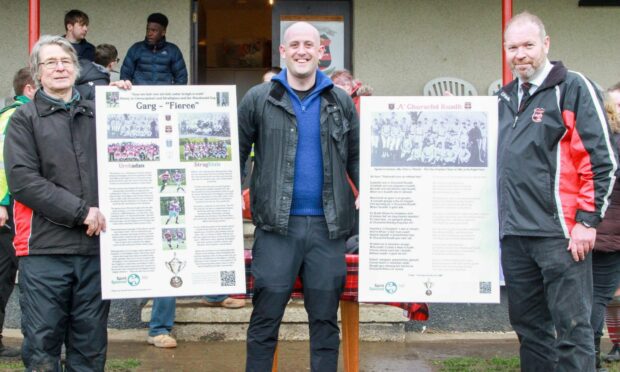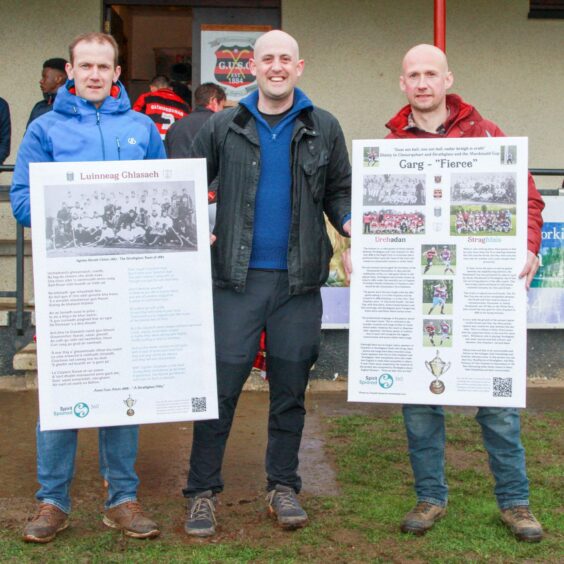A shinty rivalry – with the special bonds it creates – is being celebrated in a virtual exhibition as part of the Spirit 360 Project telling stories about the Spirit of the Highlands.
It was from famous 22-a-side matches between Strathglass and Glen Urquhart in 1887 and 1888 at the Bught Park in Inverness that the sport’s governing body, the Camanachd Association, came into being in 1893 and the still current 12-a-side game was drawn up.
Shinty, also known as Game of the Gael, camanachd, iomain or cluith-bhall, is embedded in the history of the Highlands.
And Strathglass player Eòghan Stewart, 40, has crafted an abundance of written, spoken and visual material to celebrate the long-standing links between these two clubs and communities.
The virtual exhibition called The Garg Project mixes Gaelic and English, audio recordings, poetry and imagery.
The predominate language of the players would have been Gaelic. This is reflected in the number of poems and songs written in Gaelic.
Gaelic culture at heart of project
Eòghan has put together poems and songs as part of the project using Gaelic speakers who live in Glen Urquhart and Strathglass and the English translations opens access to many others.
Incredibly, six decades passed before these opponents crossed camans again since those legendary first two meetings in Inverness.
To help revive the sport as well as games between the neighbouring districts, the Macdonald Cup was presented for play in 1948 by James Macdonald of Strathglass, one of the last surviving players of the 1887 match.
Last weekend’s National Division match at Blairbeg Park, Drumnadrochit, saw Glen post a 4-0 win over Strath as they got their hands on the Macdonald Cup, which the first-teams of these clubs compete for annually.
Macdonald Cup is vital strand
Eòghan explained why the chance to bring this fascinating story to life was too hard to resist.
He said: “When I saw the opportunity to apply to the project for a commission, I knew I really wanted to tell the story of why shinty is important to the wider Highlands, but through the prism of the Glen-Strath rivalry, both in the past and in the here and now, and how the Macdonald Cup is the unifying strand going back and forward.
“I felt it was very important that shinty could and should be part of any exhibition which tells the story of the Highlands, but through my research into the Gaelic songs I felt strongly that the Gaelic history of both areas was brought to the fore naturally as part of the art, through audio, visual and poetry.
“Within living memory, there were still numbers of Gaelic speakers native to Strathglass and Glenurquhart going about.
“With the Gaelic Medium Unit going from strength to strength in Drumnadrochit, and other Gaelic speakers having moved to the area, it’s a good enough time as any to bring this important aspect back to the attention of people.”
Silverware beyond senior sides
The men’s reserve sides also chase silverware every time they go head-to-head in the form of the Ali Ban Cup.
Glen’s Ali Ban, who was Alexander or Sandy Macdonald, scored the only goal in the 1888 match.
Also, due the great development of women’s shinty, Glen and Strath have for the past five years competed for the MacLennan Quaich, which is a tribute to Helen MacLennan, whose support for the sport in the area is well known.
It’s not all about rivalries though. Away from the pitch, opponents of these clubs share mutual respect and two examples of that, Strathglass’ Roy MacKenzie and Glen Urquhart’s Billy Maclean, discuss within the online forum why shinty and this specific community matters to them.
Inverness Castle hub for details
Information boards about the project were given to the clubs, while others will be on display within the new museum at Inverness Castle once it reopens following its transformation, estimated for 2025.
For more information about The Garg Project, visit padlet.com/gaidhligguleor/garg
The initiative has only been possible thanks to the support of the Spirit of the Highland, Spirit 360 project.
The details on this can be found at

